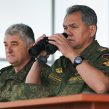
Russia Rehearses Military Intervention in Central Asia
Publication: Eurasia Daily Monitor Volume: 11 Issue: 119
By:

Russia has used a recent military exercise to rehearse intervention in Central Asia to a strategic depth of 3,000 kilometers (1,864 miles). Since the Ukraine crisis erupted earlier this year, the Kremlin has harnessed the tool of using “snap inspections” of combat readiness in the Russian Armed Forces as an additional means of exerting pressure on Kyiv. On June 21, President Vladimir Putin ordered a similar “snap inspection” in the Central Military District (MD) involving 65,000 troops, more than 180 aircraft and 60 helicopters. However, unlike earlier tests of combat readiness, the June inspection appears linked to Russian concerns over security in Central Asia following the completion of the International Security Assistance Force (ISAF) drawdown in Afghanistan (Krasnaya Zvezda, June 27).
The June 21 “snap inspection” exercise in the Central Military District involved forces from each of the four Military Districts. Eastern Military District’s 5th Combined Arms Army (CAA) was represented by the 57th, 59th and Motorized Rifle Brigades and the 8th Surface-to-Air (SAM) Brigade. The Western Military District sent the 27th Motorized Rifle Brigade, supported by elements of the Northern Fleet and the 790th Fighter Aviation Regiment (providing MiG-31, MiG-31BM, and Su-27). Meanwhile, the Southern Military District deployed the Airborne Forces (VDV) 7th Air Assault Division (Novorossiysk). However, the bulk of the force consisted of units drawn from the host– the Central Military District. These were: the 2nd Air Forces and Air Defense Forces Command (562nd Base) Tolmachevo (Mi-8 and Mi-24); VDV 31st Air Assault Brigade (Ulyanovsk), 3rd Spetsnaz Brigade, the command of the 2nd CAA under Major-General Igor Seritskiy, the 28th, 23rd (Medium) and 21st (Heavy) Motorized Rifle Brigades, the 15th Motorized Rifle Peacekeeping Brigade, 385th Artillery Brigade and the 297th SAM Brigade (Interfax, June 20–29; Nezavisimoye Voyennoye Obozreniye, June 29).
As the exercise ended on June 27, Russia’s Defense Minister Army General Sergei Shoigu and Chief of the General Staff Army General Valery Gerasimov observed its conclusion. They asserted that the exercise was designed to show the capability of the Russian Armed Forces to “create a self-sustaining group [of forces] for any operational direction.” Consequently, it appears that this exercise followed the pattern established since the operational-strategic exercise Zapad 2013, whereby the snap inspections are testing strategic mobility capabilities (Krasnaya Zvezda, June 27).
It is important, therefore, to identify some of the conceptual elements of this snap inspection exercise in order to establish that the implications for Ukraine were remote at best. The Central Military District acts as a strategic reserve for the other three MDs and is also the key support basis for any operations in Central Asia. The exercise also placed on alert forces based in Kyrgyzstan and Tajikistan. According to Central Military District’s Commander, Colonel-General Vladimir Zarudnitsky, the snap inspection showed that a force grouping can be assembled and ready to act within three days in any strategic direction; he stated that the underlying aim of the exercise was to rehearse intervention in Central Asia, “due to the impending withdrawal of International Security Assistance Force in Afghanistan.” The intervention then was modeled on supporting a host government in an Afghanistan-linked security threat to Central Asia (RIA Novosti, June 27).
Any such intervention would likely take place under the auspices of the Collective Security Treaty Organization (CSTO) and its main force, the CSTO Collective Rapid Reaction Forces (?ollektivnye Sil Operativnogo Reagirovaniya–KSOR). CSTO KSOR will stage an exercise under the name Rubezh 2014 in Chelyabinsk on July 15-18 (Russian defense ministry, May 21). Nonetheless, the forces assembled during the Central MD snap inspection were not tied directly to KSOR, implying that in certain circumstances Russia might act alone. It seems that Moscow has in mind an intervention that requires deeper and longer lasting support to KSOR as an initial response to a Central Asian security crisis. It is also worth highlighting the mixture of “light,” “medium” and “heavy” Motorized Rifle Brigades, confirming the implementation of General Staff ideas on restructuring the brigade-based system as well as the involvement of the peacekeeping brigade. Whatever the precise details of the scenario were, the force structure was quite large and varied, envisaging a sizeable deployment into Central Asia.
Russian strategic mobility remains heavily tied to railway transportation, though there is increased attention to using airlift to move lighter forces more quickly, while finding workarounds to enhance mobility. An-124-100 Ruslan heavy-lift transport aircraft airlifted Mi-24 combat helicopters from the Army Aviation’s Tolmachevo Airbase (Novosibirsk Region) to Koltsovo airfield (Sverdlovsk Region). The crews and equipment were under the operational control of Kamensk-Uralskiy Airbase (Sverdlovsk Region). A total of eight combat helicopters were airlifted in two sorties (Patriotam, RF, June 23).
In addition to testing strategic mobility and the capability of the Russian Armed Forces to assemble a force rapidly to intervene in Central Asia, other issues were at play. Close attention was paid to assessing command skills on the part of senior officers, and since the commander of the Central MD was appointed on June 16, there may have been a “getting to know you” factor in the inspection. The VDV also further tested its new automated command control system (RIA Novosti, June 27; Krasnaya Zvezda, June 27). Other troops, including VDV units, were moved to training grounds by transport aircraft.
Although the June snap inspection rehearsed Russian military intervention in Central Asia, this is not inconsistent with the country’s military exercises in recent years, and can also be seen in the annual CSTO KSOR exercises. Moreover, the force structure and scenario differed significantly from the use of military power in February-March to annex Crimea. The Afghanistan-linked scenario serves as a reminder that the Kremlin needs to calibrate into its strategic planning the potential risk of conflict erupting near Russia’s borders in various strategic directions (Nezavisimoye Voyennoye Obozreniye, June 29; Krasnaya Zvezda, June 27). The two key directions most pressing in this planning process are to the west and south of Russia. Yet, this should not be exaggerated as the largest operational-strategic exercise since Zapad 2013, as another one—Vostok 2014—will occur in the Russian Far East in September. Doubtless, Vostok 2014 will be used to send a message to Japan, China and the US that Russia intends to protect its Eastern flank and its interests in the Asia-Pacific. The June snap inspection, therefore, was not about remodeling the Crimea operation as a means to threaten Central Asia, but to offer support in a security crisis. In this sense, the security relationship between Russia and Central Asia is very much “business as usual.”




